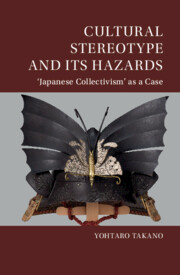Book contents
- Cultural Stereotype and Its Hazards
- Culture and Psychology
- Cultural Stereotype and Its Hazards
- Copyright page
- Contents
- Figures
- Tables
- Preface
- Acknowledgments
- Chapter 1 “Japanese Collectivism”
- Chapter 2 Psychological Studies
- Chapter 3 Japanese Culture in Real Life
- Chapter 4 Japanese Economy
- Chapter 5 Origins of “Japanese Collectivism”
- Chapter 6 Cultural Stereotype
- Chapter 7 Hazard
- Afterword
- Appendix
- References
- Index
Chapter 4 - Japanese Economy
Published online by Cambridge University Press: 21 November 2024
- Cultural Stereotype and Its Hazards
- Culture and Psychology
- Cultural Stereotype and Its Hazards
- Copyright page
- Contents
- Figures
- Tables
- Preface
- Acknowledgments
- Chapter 1 “Japanese Collectivism”
- Chapter 2 Psychological Studies
- Chapter 3 Japanese Culture in Real Life
- Chapter 4 Japanese Economy
- Chapter 5 Origins of “Japanese Collectivism”
- Chapter 6 Cultural Stereotype
- Chapter 7 Hazard
- Afterword
- Appendix
- References
- Index
Summary
“Japanese collectivism” was criticized most fiercely in the field of economy during the U.S.-Japan trade friction. The Japanese economy was alleged to be collectivistic at three levels: At the company level, Japanese workers were alleged to be loyal to their companies and thus willing to work unusally long and hard. At the company group level, Japanese complanies were alleged to form a closed group (called keiretsu) that worked as a barrier against foreign competitors. At the country level, all Japanese companies were alleged to act like a single company (“Japan Inc.”) under the direction of the Japanese government. However, economic statistics and empirical studies disclosed that all these alleged properties of Japanese economy were unreal. For example, surveys almost unanimously revealed that American workers were more loyal to their companies than Japanese workers. Although Japan was allged to protect its domestic market against American products by means of non-tariff barriers, each Japanese paid as much for American products as each American paid for Japanese products. The disputed trade imbalance was actually created by the difference in population between these two nations.
Keywords
- Type
- Chapter
- Information
- Cultural Stereotype and Its Hazards‘Japanese Collectivism' as a Case, pp. 106 - 134Publisher: Cambridge University PressPrint publication year: 2024

